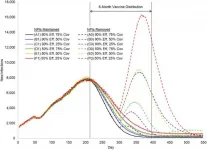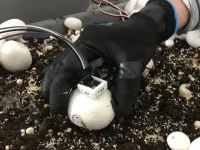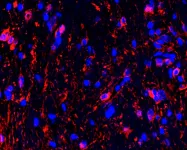INFORMATION:
COVID-19 simulation shows importance of safety efforts during vaccine distribution
Researchers have produced a mathematical simulation that evaluates how many COVID-19 cases could be avoided in North Carolina if more people get vaccinated and follow mask and physical distancing guidelines
2021-06-01
(Press-News.org) CHAPEL HILL, NC - Research published by JAMA Network Open shows how non-pharmaceutical interventions (NPIs) like mask wearing and physical distancing can help prevent spikes in COVID-19 cases as populations continue to get vaccinated. The study, led by Mehul Patel, PhD, a clinical and population health researcher in the department of Emergency Medicine at the UNC School of Medicine, focuses on the state of North Carolina. Similar modeling studies have been used in different states, and can serve as guidance to leaders as they make decisions to relax restrictions and safety protocols.
"The computer simulation modeling allows us to look at multiple factors that play a role in decreasing the spread of COVID-19 as vaccines are distributed," Patel said. "We looked at vaccine effectiveness, percent of population vaccinated, and adherence to precautions like mask wearing and physical distancing over a set period of time."
The image from the simulation is a model of multiple scenarios within the state of North Carolina. Knowing that the Pfizer and Moderna vaccines are more than 90% effective at preventing severe COVID-19, you can follow the black, purple and blue lines to see what could happen if non-pharmaceutical interventions (NPIs) like mask wearing and physical distancing are not followed while communities are vaccinated. Furthermore, the simulation also demonstrates how important it is for as many people as possible to get fully vaccinated.
For example, looking at scenario A1, if 75% of our population gets fully vaccinated and we continue to adhere to NPIs, we see a sustained decline down to very few new COVID cases over a six month period. In contrast, looking at scenario C0, if only 25% of our population gets fully vaccinated and does not adhere to NPIs, we could see a sustained increase in daily COVID cases, peaking around 8,000 before we see another decline. For reference, as of June 1, 2021, 38.9% of the entire North Carolina population has been fully vaccinated.
"As soon as you start relaxing mask wearing and physical distancing with any percent of the population vaccinated, you see an increase in cases," Patel said. "Until we reach around 50% of the population vaccinated, there is more potential to have disease spread if we remove NPIs."
ELSE PRESS RELEASES FROM THIS DATE:
New algorithm could help enable next-generation deep brain stimulation devices
2021-06-01
PROVIDENCE, R.I. [Brown University] -- By delivering small electrical pulses directly to the brain, deep brain stimulation (DBS) can ease tremors associated with Parkinson's disease or help relieve chronic pain. The technique works well for many patients, but researchers would like to make DBS devices that are a little smarter by adding the capability to sense activity in the brain and adapt stimulation accordingly.
Now, a new algorithm developed by Brown University bioengineers could be an important step toward such adaptive DBS. The algorithm removes a key hurdle that makes it difficult for DBS systems to sense brain signals while simultaneously delivering stimulation.
"We know that there are electrical signals ...
Researchers develop prototype of robotic device to pick, trim button mushrooms
2021-06-01
Researchers in Penn State's College of Agricultural Sciences have developed a robotic mechanism for mushroom picking and trimming and demonstrated its effectiveness for the automated harvesting of button mushrooms.
In a new study, the prototype, which is designed to be integrated with a machine vision system, showed that it is capable of both picking and trimming mushrooms growing in a shelf system.
The research is consequential, according to lead author Long He, assistant professor of agricultural and biological engineering, because the mushroom industry has been facing labor shortages and rising labor costs. Mechanical or robotic picking can help alleviate those problems.
"The mushroom industry in Pennsylvania is producing about two-thirds of the mushrooms ...
Adults With Cognitive Impairment Who Use Pain Medication Have Higher Falls Risk
2021-06-01
Older adults with cognitive impairment are two to three times more likely to fall compared with those without cognitive impairment. What's more, the increasing use of pain medications for chronic pain by older adults adds to their falls risk. Risks associated with falls include minor bruising to more serious hip fractures, broken bones and even head injuries. With falls a leading cause of injury for people aged 65 and older, it is an important public health issue to study in order to allow these adults increased safety and independence as they age.
Although elevated risk of falls due to use of pain medication by older adults has been widely studied, less ...
Optic nerve firing may spark growth of vision-threatening childhood tumor
2021-06-01
In a study of mice, researchers showed how the act of seeing light may trigger the formation of vision-harming tumors in young children who are born with neurofibromatosis type 1 (NF1) cancer predisposition syndrome. The research team, funded by the National Institutes of Health, focused on tumors that grow within the optic nerve, which relays visual signals from the eyes to brain. They discovered that the neural activity which underlies these signals can both ignite and feed the tumors. Tumor growth was prevented or slowed by raising young mice in the dark or treating them with an experimental cancer drug during a critical period of cancer development.
"Brain cancers recruit the resources they need from the environment ...
Modulating rapamycin target protein promotes autophagy, lowering toxic Huntingtin protein
2021-06-01
Researchers world-wide are focused on clearing the toxic mutant Huntingtin protein that leads to neuronal cell death and systemic dysfunction in Huntington's disease (HD), a devastating, incurable, progressive neurodegenerative genetic disorder. Scientists in the Buck Institute's Ellerby lab have found that the targeting the protein called FK506-binding protein 51 or FKBP51 promotes the clearing of those toxic proteins via autophagy, a natural process whereby cells recycle damaged proteins and mitochondria and use them for nutrition.
Publishing in Autophagy , researchers showed that FKBP51 promotes autophagy through a new mechanism that could avoid worrisome side ...
Sloan Kettering Institute scientists learn what fuels the 'natural killers' of the immune system
2021-06-01
Despite a name straight from a Tarantino movie, natural killer (NK) cells are your allies when it comes to fighting infections and cancer. If T cells are like a team of specialist doctors in an emergency room, NK cells are the paramedics: They arrive first on the scene and perform damage control until reinforcements arrive.
Part of our innate immune system, which dispatches these first responders, NK cells are primed from birth to recognize and respond to danger. Learning what fuels NK cells is an active area of research in immunology, with important clinical implications.
"There's a lot of interest right now ...
Scientists develop novel therapy for crimean-congo hemorrhagic fever virus
2021-06-01
Army scientists working as part of an international consortium have developed and tested an antibody-based therapy to treat Crimean-Congo hemorrhagic fever virus (CCHFV), which is carried by ticks and kills up to 60 percent of those infected. Their results are published online today in the journal Cell.
Using blood samples donated by disease survivors, the study's authors characterized the human immune response to natural CCHFV infection. They were able to identify several potent neutralizing antibodies that target the viral glycoprotein--a component of the virus that plays a key role ...
New evidence may change timeline for when people first arrived in North America
2021-06-01
AMES, Iowa - An unexpected discovery by an Iowa State University researcher suggests that the first humans may have arrived in North America more than 30,000 years ago - nearly 20,000 years earlier than originally thought.
Andrew Somerville, an assistant professor of anthropology in world languages and cultures, says he and his colleagues made the discovery while studying the origins of agriculture in the Tehuacan Valley in Mexico. As part of that work, they wanted to establish a date for the earliest human occupation of the Coxcatlan Cave in the valley, so they obtained radiocarbon dates for several rabbit and deer bones that were collected from the cave in the 1960s as part of the Tehuacan Archaeological-Botanical Project. The dates for the bones suddenly ...
Innovative surgical simulator is a significant advance in training trauma teams
2021-06-01
Key takeaways
The surgical simulator can realistically simulate multiple trauma scenarios at once, compared with traditional simulators that can only simulate one or a limited number of conditions.
Trauma team members who tested the simulator preferred it for its realism, physiologic responses, and feedback.
The benefits of this innovative simulator may be able to extend to other surgical procedures and settings.
CHICAGO (June 1, 2021): Simulators have long been used for training surgeons and surgical teams, but traditional simulator platforms typically have a built-in limitation: they often simulate one or a limited ...
New method to improve durability of nano-electronic components, further semiconductor manufacturing
2021-06-01
University of South Florida researchers recently developed a novel approach to mitigating electromigration in nanoscale electronic interconnects that are ubiquitous in state-of-the-art integrated circuits. This was achieved by coating copper metal interconnects with hexagonal boron nitride (hBN), an atomically-thin insulating two-dimensional (2D) material that shares a similar structure as the "wonder material" graphene.
Electromigration is the phenomenon in which an electrical current passing through a conductor causes the atomic-scale erosion of the material, eventually resulting in device failure. Conventional semiconductor technology addresses this challenge by using a barrier or liner material, but this takes up precious space on the wafer that could otherwise be used to pack in ...
LAST 30 PRESS RELEASES:
An ‘illuminating’ design sheds light on cholesterol
Who is more likely to get long COVID?
Study showcases resilience and rapid growth of “living rocks”
Naval Research Lab diver earns Office of Naval Research 2025 Sailor of the Year
New Mayo-led study establishes practical definition for rapidly progressive dementia
Fossil fuel industry’s “climate false solutions” reinforce its power and aggravate environmental injustice
Researchers reveal bias in a widely used measure of algorithm performance
Alcohol causes cancer. A study from IOCB Prague confirms damage to DNA and shows how cells defend against it
Hidden viruses in wastewater treatment may shape public health risks, study finds
Unlock the power of nature: how biomass can transform climate mitigation
Biochar reshapes hidden soil microbes that capture carbon dioxide in farmland
Reducing saturated fat intake shows mortality benefit, but only in high-risk individuals
Manta rays create mobile ecosystems, study finds
Study: Mixed results in using lipoic acid to treat progressive multiple sclerosis
Norbert Holtkamp appointed director of Fermi National Accelerator Laboratory
New agentic AI platform accelerates advanced optics design
Biologists discover neurons use physical signals — not electricity — to stabilize communication
Researchers discover that a hormone can access the brain by hitchhiking
University of Oklahoma researcher awarded funding to pursue AI-powered material design
Exploring how the visual system recovers following injury
Support for parents with infants at pediatric check-ups leads to better reading and math skills in elementary school
Kids’ behavioral health is a growing share of family health costs
Day & night: Cancer disrupts the brain’s natural rhythm
COVID-19 vaccination significantly reduces risk to pregnant women and baby
The role of vaccination in maternal and perinatal outcomes associated with COVID-19 in pregnancy
Mayo Clinic smartwatch system helps parents shorten and defuse children's severe tantrums early
Behavioral health spending spikes to 40% of all children’s health expenditures, nearly doubling in a decade
Digital cognitive behavioral treatment for generalized anxiety disorder
Expenditures for pediatric behavioral health care over time and estimated family financial burden
Air conditioning in nursing homes and mortality during extreme heat
[Press-News.org] COVID-19 simulation shows importance of safety efforts during vaccine distributionResearchers have produced a mathematical simulation that evaluates how many COVID-19 cases could be avoided in North Carolina if more people get vaccinated and follow mask and physical distancing guidelines



